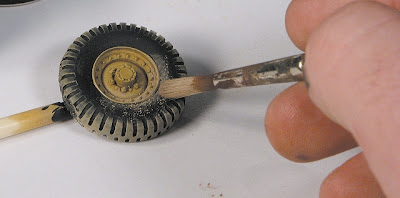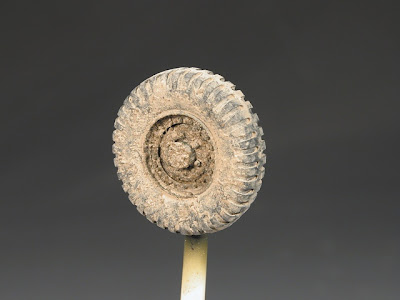Extracted from MIG Jimenez book:
The wheels can totally alter our model's appearance (in contrast to tracks on tanks, where almost any solution can more or less work well). You should pay attention to the environment where our vehicle is to be located, trying to define it as much as possible. That is, a truck wheel in a desert plain will not have the same appearance as the same truck in the same desert zone, but travelling on a road. The dust, mud and other effects act on these elements in a very special way depending on how they are present in the surroundings and what the vehicle is doing at that particular moment in time. You should observe vehicles in your usual surroundings; your own car can serve as an example, but also the diggers and trucks that you can see in your streets every day. Hence, you will be able to describe the immense number of variables that can affect a wheel.
I have felt it necessary to gather together five different types of wheels, in different environments and situations that cover the majority of our needs. The examples have been taken from the same model of wheel (specifically an American wheel) that could well be situated in any place in the world. You should remember that techniques can be applied to any wheel on any type of vehicle at any time of year.
1. How to paint wheels in desert asphalt zones?
1- The vehicle base colour is painted with Tamiya paints.
2- Then the tyres are painted using black acrylic pigments.
3- Gulf War Sand is applied with a paintbrush particularly insisting on the tyre.
4- Afterwards, the surface is soaked with Thinner to fix the pigment, moving in a circular motion towards the centre of the wheel.
5- Once dry, the appearance should be very uneven.
6- Now, the tread of the tyre is treated dry-brushed, using a dark grey Humbrol paint.
7- This is the resulting effect.
2. How can I paint wheels in a desert terrain?
1- The vehicle base colour is painted with Tamiya paints
2- Then the tyres are painted using black acrylics.
3- The tyre tread is dry-brushed with the whiter Humbrol number 94 paint.
4- Now pigment is applied around the wheel rim, using pressure with the paintbrush to ensure the paint’s adherence.
5- This is the resulting effect.
3. How can I paint wheels on asphalt in the winter season?
1- The vehicle base colour is painted with Tamiya paints.
2- Then the tyres are painted using black acrylics.
3- Using the Tamiya buff colour paint applied with a paintbrush, soft water marks are painted in a radial direction. The paint must be highly diluted.
4- Now a prior mudding will be applied, using Humbrol brown paints and oils, painting from the centre outwards.
5- A mixture of plaster, gloss varnish and brown colour Humbrol and oil paints is made.
6- It is mixed well until a quite thick paste is achieved.
7- Air is directed over the paintbrush containing the paste with an airbrush, attempting to splash the wheel in a radial fashion.
8- The final appearance should offer a variety of different gloss and satin finishes.
4. How should I paint wheels on asphalt in a hot season?
1- The vehicle base colour is painted with Tamiya paints.
2- Then the tyres are painted using black acrylics.
3- Pigment is applied with a paintbrush with pressure, over the whole surface.
4- Afterwards, the surface is soaked with Thinner to fix the pigment, moving in a circular motion towards the centre of the wheel.
5- Now a dry-brushing is applied on the wheel, using a dark grey Humbrol paint.
6- Appearance of the wheel before creating the splashing.
7- Tamiya buff colour paint is mixed with an abundance of water a paintbrush is soaked with the liquid. Air is directed over the paintbrush with an airbrush to splash the wheel.
8- A very fine splashing should be created in a radial direction towards the centre of the wheel.
9- The finished wheel.
5. How should I paint wheels in a muddy terrain?
1- The vehicle base colour is painted with Tamiya paints.
2- Then the tyres are painted using black acrylics
3- Some soft water marks are applied in a radial direction with a paintbrush and a buff colour Tamiya paint. The paint should be highly diluted.
4- We are going to prepare a mixture of light mud with plaster, pigments and acrylic resin. A drop of resin is deposited over the pigments and plaster.
5- With an old paintbrush and a few drops of water, the mixture is stirred until a paste is obtained.
6- Air is directed over the paintbrush to remove the excess mud mixture.
7- Now the same is done for the wheel.
8- The process is repeated with different colours and left to dry between coats.
9- The next step is prepared with a mud colour pigment and gloss varnish.
10- The mixture is removed with a paintbrush.
11- Now it is applied over the wheel tread, attempting to paint a part of the sides in an uneven manner.
12- Appearance of the finished wheel.













































